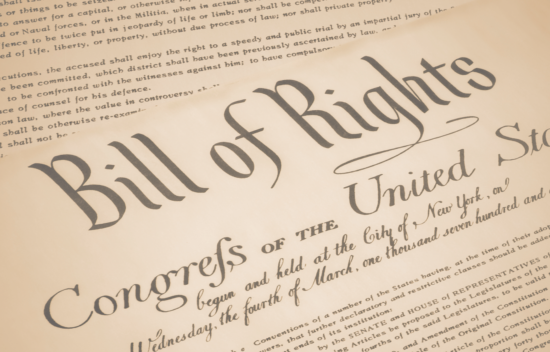
Discussing Controversial Topics: The Second Amendment
Resources
Bill of Rights Institute Resources
- The United States Constitution
- The United States Bill of Rights
- District of Columbia v. Heller (2008)
- McDonald v. Chicago (2010)
News Resources
- Temple massacre has some Sikhs mulling gun ownership, FOX News
- Candidates show little appetite for new gun control laws, CNN
- Gunman Dies After Killing at Empire State Building, New York Times
Activity/How to Use
- To prepare, students should read each of the above news articles, and other primary sources listed above before the activity.
- Students should think about these questions on their own as they read:
- What right does the Second Amendment protect?
- No right in the Bill of Rights is considered absolute. What limits on firearms has the Supreme Court ruled are constitutional? What limits on firearms do you believe are constitutional?
- Students should think about these questions on their own as they read:
- In class, divide students into two equal groups:
- One group should prepare to argue that high profile shootings are reasons to increase gun control.
- The other should prepare to argue that high profile shootings are reasons to loosen restrictions on firearms.
- Tell the students they will take part in a civil class debate following these directions:
- Speak courteously: No raised voices or insults.
- Listen courteously: No interruptions.
- Argue authoritatively: Use primary sources to support reasoning.
- Have the students prepare for the debate with their group.
- Distribute “Questions to Consider” to help students prepare their data and arguments. The teacher may add additional questions during the debate to help clarify or extend arguments.
- Students should have time to work as a group to prepare their arguments using the sources above.
- Students will have to think about why they are for or against increasing or decreasing gun control.
- Students should use primary sources and facts to support their argument.
- Students should think about why the opposing group believes what they believe and be able to respond to that argument.
- After the students are prepared, the teacher will ask the “Questions to Consider” to both sides who will answer the questions one side at a time.
- Alternate which team answers the questions first.
- Allow students from the opposing group to ask clarifying questions if necessary.
- Give each group a time limit on each question to keep the debate moving.
Questions to Consider
- What right does the Second Amendment to the Constitution protect? Do you think this protection is necessary? Why or why not?
- Why did the Founders include the Second Amendment in the Bill of Rights? Do you think that their reasons are still valid today? Why or why not?
- What has the Supreme Court ruled about the meaning of the Second Amendment? Do you agree with their reasoning and conclusions?
- What types of restrictions have local and state governments put on weapons? What laws have local and state governments proposed? Do you support or oppose these restrictions? Explain.
- What laws would you propose regarding gun control? How do you think the public would react to your ideas?
- Why do you think gun control is controversial?
- During the Empire State Building shooting, it is believed that police officers fired shots at the accused shooter and accidentally wounded nine bystanders. A grand jury is now reviewing evidence in this case to determine whether the officers should stand charges. How does this knowledge impact your understanding of the Second Amendment? How does it impact your opinion on gun control regulations?
Extension
- After the debate, students should think about what they learned from reading the articles and debating on the the topic. They should write a brief essay explaining what they learned and if their opinion changed after thinking about the issue.
- Students should research laws regarding guns in your state or community and then write a brief essay explaining one of the laws. Examples may include limits on sale or ownership of certain weapons, concealed carry requirements, limits on gun purchases, or others. Their essay should include reasons the law was proposed or passed, what the final vote on the law was, and how the community reacted to the law.


